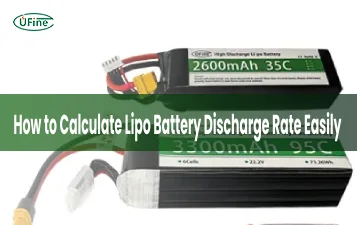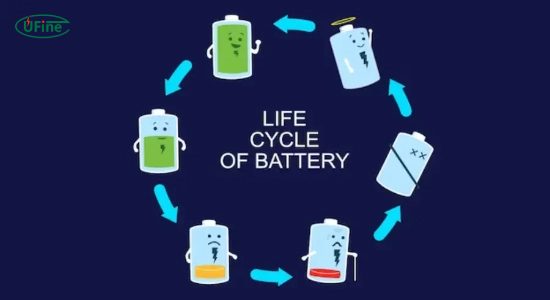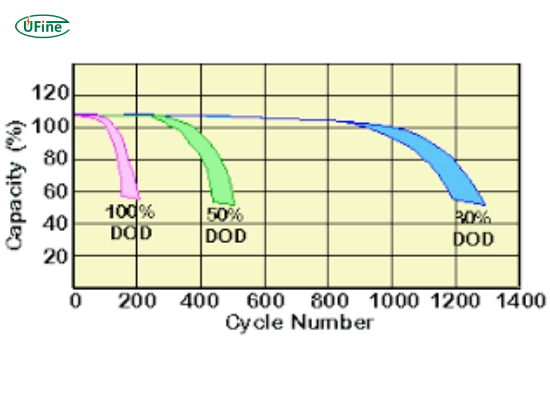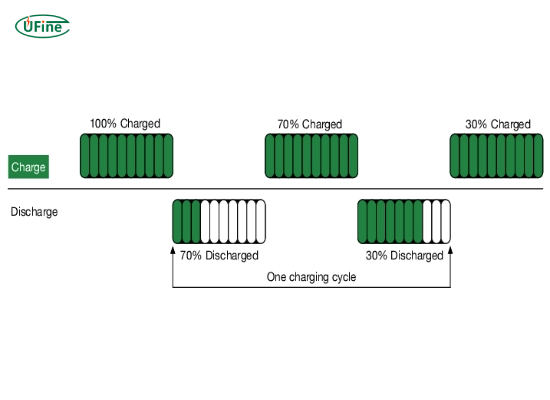Understanding the lithium ion cycle life is essential for managing battery performance. This article explains the importance of battery cycle counts, differences between deep and shallow charging, recycling feasibility, and practical tips to extend battery lifespan.
Part 1. What is lithium-ion cycle life?
Lithium ion cycle life refers to the number of complete charge-discharge cycles a battery can perform before its capacity significantly degrades. On average, lithium-ion batteries can endure 300–500 cycles, depending on usage and maintenance. Proper charging practices can double their lifespan.
Part 2. What is a battery cycle count?
A battery cycle count is the process of charging a lithium-ion battery from its lowest capacity to its full charge, then discharging it back to its minimum. Each full cycle contributes to the gradual degradation of the battery’s capacity over time, directly impacting its cycle life.
Cycle Life Importance:
Tracking cycle counts is essential because lithium-ion batteries lose a small portion of their capacity with each cycle. For example, after 500 cycles, a typical lithium battery may retain only 80% of its original capacity. Proper usage can significantly reduce this degradation, extending the battery’s usable lifespan.
Related Tip:
To maximize cycle life, avoid full discharges and charge the battery partially, as frequent deep cycles can accelerate wear.
Part 3. What is lithium battery deep and shallow charging?
Lithium Battery Deep Charge
Deep charging involves filling a lithium-ion battery to its maximum capacity, typically indicated as reaching 100% charge. During a deep charge, the battery cell’s electrodes absorb as much energy as possible. However, this process significantly stresses the battery, particularly at the upper and lower charge extremes. When consistently charged to total capacity, the battery’s internal chemical reactions experience strain, accelerating degradation and reducing overall longevity.
Lithium Battery Shallow Charge
Shallow charging, in contrast, refers to partial charging of a lithium-ion battery, where the battery is charged to a certain level below its maximum capacity. Rather than aiming for 100% charge, users set their devices to, for example, 20% or 50%. This method eases the strain on the battery, preventing it from reaching its upper charge limit. However, repeated shallow charges without periodic total charges can potentially lead to a loss of battery calibration and affect the accuracy of battery percentage indicators.
Part 4. How to prolong the cycle life of lithium batteries?
Optimized Charging Approaches
- Partial Discharges: Opt for partial discharges instead of completely draining the battery to reduce stress and prolong its life span.
- Optimal Charging Levels: Charging the battery to around 80% capacity can alleviate strain on cells and enhance long-term battery health.
- Temperature Control: Charging at moderate temperatures safeguards the battery from accelerated degradation.
Charging Techniques
- Utilize Manufacturer-Recommended Chargers: Employ chargers designed explicitly for the lithium battery model to ensure safe and efficient charging.
- Limit Fast Charging: Reduce frequent use of fast charging, which may expedite battery wear and compromise longevity.
Storage Guidelines
- Ideal Charge Levels for Storage: Maintain lithium batteries at approximately 50% charge when storing for extended periods to mitigate strain and preserve health.
- Considerate Storage Conditions: Store batteries in moderate-temperature environments to retain their integrity.
Maintenance and Calibration
- Firmware Updates: Keep device firmware updated to optimize battery management systems and charging efficiency.
- Periodic Calibration: Calibrate devices occasionally for accurate battery level readings.
Usage Habits
- Load Management: Limit activities that heavily strain the battery, such as simultaneous resource-intensive applications.
- Protect from Extreme Conditions: Shield batteries from extreme environments to maintain optimal performance.
Regular Checks
- Battery Health Monitoring: Routinely assess battery health through available diagnostics or dedicated applications to detect issues promptly.
- Prevent Overcharging: Unplug devices once they reach full charge to avoid overcharging and alleviate stress on the battery.
Did You Know?
- According to a 2023 study published in Battery Technology Journal, maintaining lithium-ion batteries between 20% and 80% charge can extend their cycle life by 40%.
- Fast charging increases heat, which accelerates battery degradation. Charging at normal speeds prolongs battery lifespan.
Additional Tip: Always store lithium batteries at 50% capacity in a cool, dry place to prevent chemical degradation.
Part 5. Can lithium batteries be recycled?
Lithium batteries are indeed recyclable, and recycling involves intricate steps to extract valuable materials for reuse.
Collection and Sorting
- Collection: Recycling begins with collecting discarded lithium batteries from various sources like electronic waste disposal centers, recycling facilities, or specialized collection programs.
- Sorting: Batteries are sorted based on type, chemistry, size, and condition. This segregation is crucial for efficient recycling.
Discharge and Shredding
- Discharge: To mitigate safety risks, collected batteries are discharged of any remaining energy. This step minimizes hazards during the subsequent processing stages.
- Shredding: The batteries undergo shredding, breaking them down into smaller components. This step involves crushing or shearing the batteries to facilitate the extraction process.
Material Extraction
- Mechanical Separation: Shredded battery components undergo automated processes like crushing and sieving to separate different materials.
- Chemical Treatment: Chemical processes extract valuable materials like lithium, cobalt, and nickel. Solvents, acids, or high-temperature treatments are used to separate these materials.
Refining and Purification
- Purification: Extracted materials undergo purification processes to remove impurities, ensuring the recovered materials meet quality standards.
- Refining: The purified materials are refined to enhance their quality for reuse in battery manufacturing or other industries.
Environmental Benefits and Challenges
- Environmental Benefits: Recycling lithium batteries reduces the demand for raw materials, minimizes the ecological impact of mining, and lowers energy consumption in manufacturing.
- Challenges: The recycling process faces challenges like the need for advanced technologies, cost-intensive procedures, and handling various battery chemistries efficiently.
Part 6. FAQs
-
What is the best charging routine for lithium batteries?
For optimal battery health, it’s recommended to charge lithium batteries partially rather than fully and avoid deep discharges. Setting them to around 80% and preventing total discharges can prolong battery lifespan. -
Is it OK to leave a lithium-ion battery on the charger?
It’s generally safe to leave a lithium-ion battery on the charger after it reaches full charge due to built-in mechanisms to prevent overcharging. However, long-term storage at full charge can slightly degrade the battery. -
Is it best to leave lithium batteries charged or uncharged?
Lithium batteries are best stored at around 40%-60% of their charge capacity for prolonged storage to minimize battery stress. Keeping them fully charged or discharged for extended periods can impact their long-term health. -
How many cycles does a lithium-ion battery last?
A typical lithium-ion battery lasts 300–500 full charge cycles, though proper charging habits (such as avoiding deep discharges and full charges) can increase its lifespan to over 1000 cycles. -
How can I extend the cycle life of a lithium-ion battery?
Avoid fully draining your battery, charge it to around 80%, and maintain moderate temperatures. Use the original charger and avoid excessive fast charging. -
What is the lithium-ion battery charging cycle?
A charging cycle refers to the process of charging a battery from near zero to full and then discharging it back to near zero. Partial charges are less taxing and can extend battery cycle life.
Related Tags:
More Articles

LiPo Battery Discharge Rate Guide & Calculation Tips
Understand LiPo battery discharge rates, C-ratings, and how to calculate max current. Essential guide for RC, drones, and electronics users.
High‑Capacity 3S LiPo Batteries: 5000 mAh vs. 10000 mAh
Compare 3S LiPo 5000mAh vs 10000mAh batteries by weight, power, and use. Find the best fit for your drone, RC car, or boat setup.
Top 5 Applications for Small 3S LiPo Batteries
Small 3S LiPo batteries power drones, RC gear, wearables, and robotics with high energy and low weight. Making them ideal for compact electronics projects.
Building and Charging Your Own 3S LiPo Pack: A Step‑by‑Step Guide
Learn how to build, balance, and charge a 3S LiPo battery pack safely at home with this complete DIY guide for hobbyists and beginners.
How to Choose the Right LiPo Battery Plug Type?
Discover the best LiPo battery plug types, how to choose them, and expert tips for safe usage, soldering, and maintenance.






